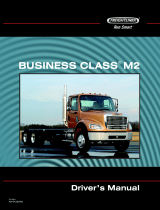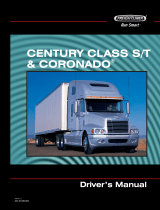Page is loading ...

BW2266 ©2011 Bendix Commercial Vehicle Systems LLC, a member of the Knorr-Bremse Group 7/11 • All Rights Reserved • Printed in U.S.A.
Introduction to
Understanding Bendix
®
Anti-lock Braking Systems
(ABS)
for Air Braked Vehicles
This booklet is an introduction to ABS for vehicles with standard ABS features.
For vehicles with Bendix advanced ABS features such as
ESP
®
stability systems, see booklet BW2489
Sources of Additional Information about
your Bendix
®
ABS System
Consult the vehicle manufacturer’s documentation.
Visit www.bendix.com for free downloads of
Service Data sheets, or go to
the Literature Center at bendix.com.
Contact the Bendix Tech Team at
1-800-AIR-BRAKE (1-800-247-2725)
Representatives are available
Mon. - Fri. 8:00 a.m. to 6:00 p.m. EST.
Mode
ABS
Lamp
ATC
Lamp
Trailer
ABS
Lamp
At Vehicle Startup
Ignition on - start
up (trailer with
PLC)
On for 3
seconds*
On for
2.5
seconds*
On for 3
seconds*
*If any of the
described lamp
behaviors do not
occur — or if the
lamp remains on
during operation
— have the
vehicle serviced
by a qualied
mechanic as soon
as possible to
restore full system
functionality.
3 seconds after
ignition (with no
Diagnostic Trouble
Codes)
Lamp
Off*
Lamp
Off*
Lamp
Off*
Special Mode Operation
During an
Automatic Traction
Control (ATC)
Event
Lamp
Off
Lamp
ashes
quickly
• Reduces wheel slip during
acceleration at low speeds
ABS
Off-Road
Mode
Normal
Lamp
ashes
slowly
Lamp Off
• Uses dash switch
• Not for rm road surfaces
• Allows more wheel lock-up
(less ABS intervention)
• Mode only applies under
25 mph (Over 25 mph, the
system reverts to full ABS,
and ATC lamp goes off)
During
an ATC
Event
Lamp
ashes
quickly
ATC
Deep
Mud/
Snow/
Mode
Normal
Lamp
Off
Lamp
ashes
slowly
• Uses dash switch
• Increases allowable wheel
slip during ATC interventions
• Not for rm road surfaces
During
an ATC
Event
Lamp
ashes
quickly
Traction Control Override Lamp On
• Uses dash switch
• ATC system switched off
65
ABS and ATC
Indicator Lamps
Chart
• Brake-light-only powered ABS: Each time the brakes are applied the warning
lamp will come on for approximately 3 seconds and then turn off. If the lamp
remains on during braking, ABS may not be operating. The vehicle will
retain normal service braking, although without the benets of ABS. Have
the trailer serviced as soon as possible to restore ABS operation.
ATC Indicator Lamp
If your vehicle is also equipped with the optional Automatic Traction Control
(ATC) system, a third indicator lamp will be installed on the dash. (The same
lamp is also used to indicate the ATC “Mud/Snow” mode, see below.)
• During the bulb check at vehicle ignition your ATC indicator lamp will
illuminate for approximately two and a half seconds and then turn off. If the
ATC indicator lamp does not illuminate at ignition, or if it remains on steadily
(not ashing) after ignition, or if it illuminates steadily (not ashing) while
you are driving (except in off-road mode), the ATC system may not be fully
functional or its operation may be completely disabled. If this happens,
your vehicle will still have normal service braking and it still can be driven,
although without the benets of ATC. Have the vehicle serviced by a qualied
mechanic as soon as possible to restore full ATC functionality.
• The ATC indicator lamp also ashes continually (at different rates) to show
that either: the off-road mode is being used, or during an ATC intervention
event.

What is the optional ABS Off-Road Mode?
This is an optional ABS feature operated by a dash-mounted switch for use when
operating your vehicle “off-road” on soft surfaces. Below 25 mph (40.2 kmh), this
feature improves ABS performance under off-road operating conditions. If your
vehicle is equipped with this feature, depress the “ABS off-road” switch when
operating on soft surfaces. Always remember to turn the ABS off-road feature off
when driving on a rm road surface. A new ignition cycle, or a second depression
of the off-road switch, will turn this function off and restore normal ABS functionality.
WARNING! The ABS off-road mode should not be used on normal, paved road
surfaces because vehicle stability and steerability may be reduced. The ABS
indicator lamp will ash slowly to indicate to the driver that the ABS off-road mode
is engaged.
What is Automatic Traction Control (ATC)?
ATC is an optional feature for Bendix
®
ABS-equipped vehicles. ATC controls wheel
spin during vehicle acceleration to improve traction.
• The ATC system will intervene automatically and apply braking pressure to a
spinning wheel transferring engine power to other drive wheels that have better
traction. This feature is active only at speeds below 25 mph (40.2 kmh).
• If all of the drive wheels begin to spin, the ATC system will reduce engine throttle
to improve traction at all of the drive wheels.
What is the Optional Deep Mud/Snow Mode?
This is an optional ATC feature operated by a dash-mounted switch. This function
allows greater engine power and more wheel spin during ATC operation. On vehicles
equipped with this feature, depress the “Mud/Snow” switch when operating on soft
road surfaces. The ATC lamp will ash slowly whenever the ATC system is operating
in the Mud/Snow mode. Always remember to turn the Mud/Snow feature off
when driving on a rm road surface. A new ignition cycle, or a second depression
of the Mud/Snow switch, will turn this function off.
What is Traction Control Override?
Another optional feature operated by a switch in the dash. When enabled, the ATC
lamp remains on to indicate that the ATC system has been turned off.
How Do I Operate a Vehicle with ATC?
If drive wheels begin to lose traction during acceleration, ATC will engage
automatically to assist the driver in accelerating the vehicle. The ATC lamp will
ash rapidly to let you know whenever ATC is actively functioning.
Note: For vehicles equipped with an interaxle differential lock switch, you should
consult the vehicle Operator’s Manual for additional information about that feature.
Typically, the driver is advised to stop the wheels from spinning and engage the
interaxle differential lock switch, but you should always follow the specic instructions
given in your vehicle’s Operator’s Manual for this feature and your vehicle’s particular
conguration.
What Is ABS?
ABS is an electronic control system that improves vehicle stability and steerability
by preventing wheel lock during braking.
How Does ABS Work?
The ABS system monitors wheel rotation, and if it detects any wheel locking up,
the system automatically reduces the brake pressure at that wheel. If necessary,
the ABS system automatically modulates braking forces at one or more of the wheel
ends. The system maintains lateral stability by preventing wheel lock during braking.
Important Safety Information About Bendix
®
Antilock Braking Systems (ABS)
Braking with ABS
• Do not pump your brakes. Use steady, even brake applications. Apply the
brake pedal with the same pressure as you would without ABS. If you are towing
a vehicle that is not equipped with ABS, you may need to adjust your braking
applications in some instances. See below.
• Do not attempt to modulate your brake applications to prevent wheel lock.
The system controls braking pressure automatically and independently at each
wheel end.
Limitations of ABS
• ABS does not apply the brakes automatically. It’s still up to you to apply the
brakes at the right time and with the right amount of pedal force. A basic ABS
system only starts to do its job after you apply the brake pedal.
• ABS is not a substitute for safe driving. Even with ABS, you must remain alert,
react appropriately and in a timely manner, and drive defensively. Don’t take
unnecessary risks. Cautious driving practices, such as maintaining an adequate
distance away from the vehicle ahead, not speeding, anticipating obstacles
and adjusting your vehicle’s speed for trafc, weather and road conditions, are
essential for safe operation.
Towed Vehicles Without ABS
Some towed vehicles, especially older trailers built before 2001, may not be
equipped with their own ABS systems. Use extra care when towing a vehicle that
is not equipped with its own ABS system. During emergency braking or braking
on slippery surfaces, a non-ABS equipped trailer could lose its lateral stability and
swing out if its wheels lock up. Use your mirrors to watch carefully and adjust your
brake applications as necessary to keep your tractor and the non-ABS equipped
towed vehicle in line with each other. Tractor ABS helps reduce the tendency to
jackknife, but it cannot prevent a non-ABS equipped trailer from swinging out.
Understanding Your ABS System
Dash Indicator Lamps
Tractor ABS Indicator Lamp
An amber ABS Indicator Lamp is typically located on the dashboard.
• At each vehicle ignition your ABS indicator lamp should illuminate as a bulb
check for approximately three seconds and then turn off. If the lamp does
not illuminate at ignition, you should have the vehicle serviced by a qualied
mechanic as soon as possible. Note: without a functioning indicator lamp,
you may not be able to determine the ABS status without using an external
diagnostic tool.
• If the indicator lamp remains on for more than three seconds after ignition,
or if it illuminates while you are driving, the ABS system may not be fully
functional or may be completely disabled. If the ABS is completely disabled
or not functioning properly, your vehicle will still have normal service braking
and it still can be driven, although without the benets of ABS. Have the
vehicle serviced by a qualied mechanic as soon as possible to restore full
ABS functionality.
• The ABS lamp is also used to indicate the optional off-road ABS mode. The
lamp will ash continually when the vehicle is operating in the off-road mode.
If the lamp stays on or illuminates during driving, ABS is not functional and
should be serviced. The vehicle will retain normal service braking, but without
the benets of ABS.
Trailer ABS Indicator Lamp
The Trailer ABS Indicator Lamp is also dash-mounted.
All trailers built since March, 2001 are able to communicate with the towing
vehicle and to operate the trailer ABS indicator lamp on the towing vehicle’s
dash. The dash-mounted Trailer ABS Indicator Lamp is in addition to a Trailer
ABS Indicator Lamp that is mounted on the side of the trailer itself.
All new trailers built since March 1, 2001 are equipped with an amber ABS
warning lamp located on the driver’s side near the rear of the trailer. The
operation of the lamp varies depending on how the ABS system is powered:
• Full-time powered ABS (usually obtaining power over the blue line of the
J560 connector): The trailer ABS warning lamp will function just like the
tractor ABS warning lamp, listed above.
Continued over . . .
3 42
/







